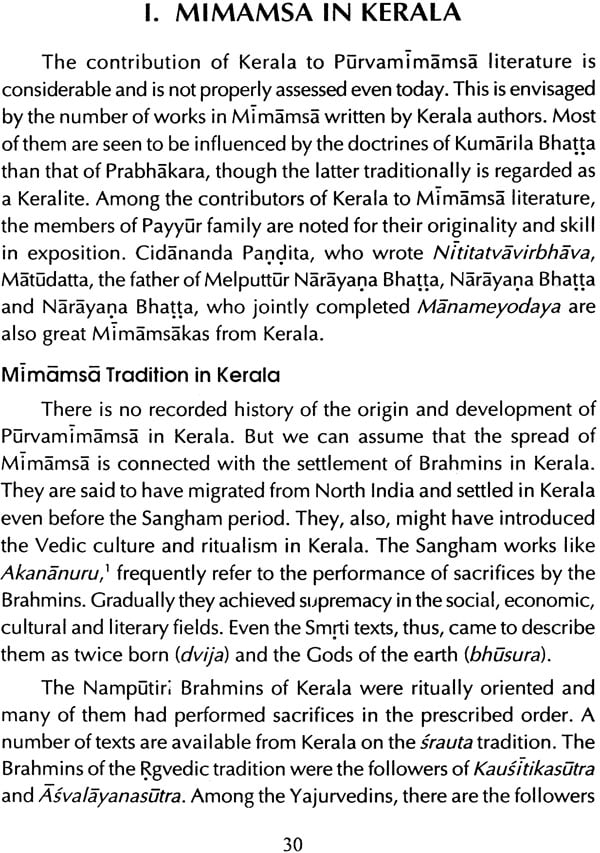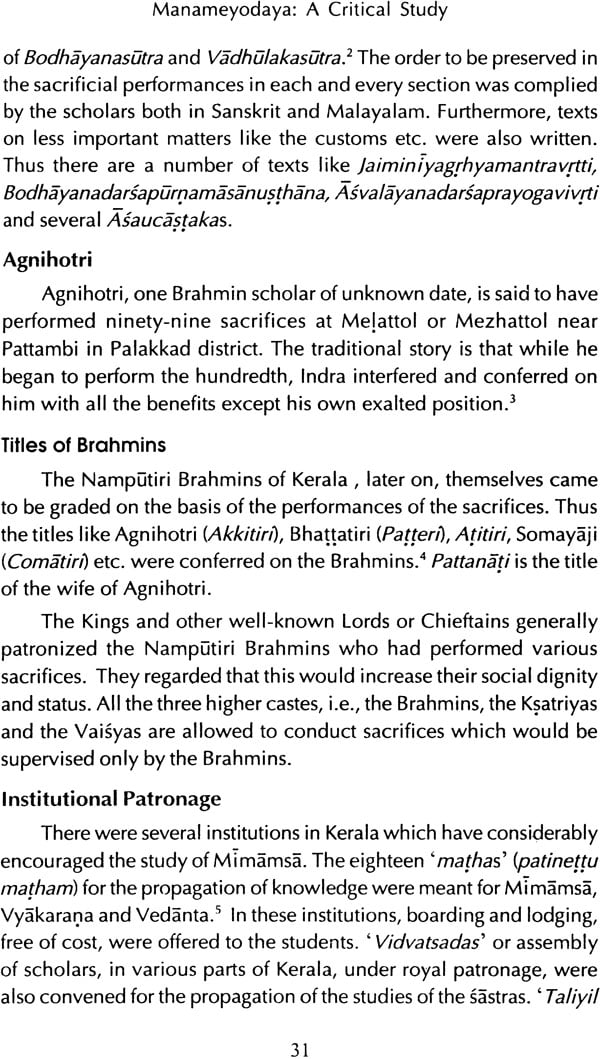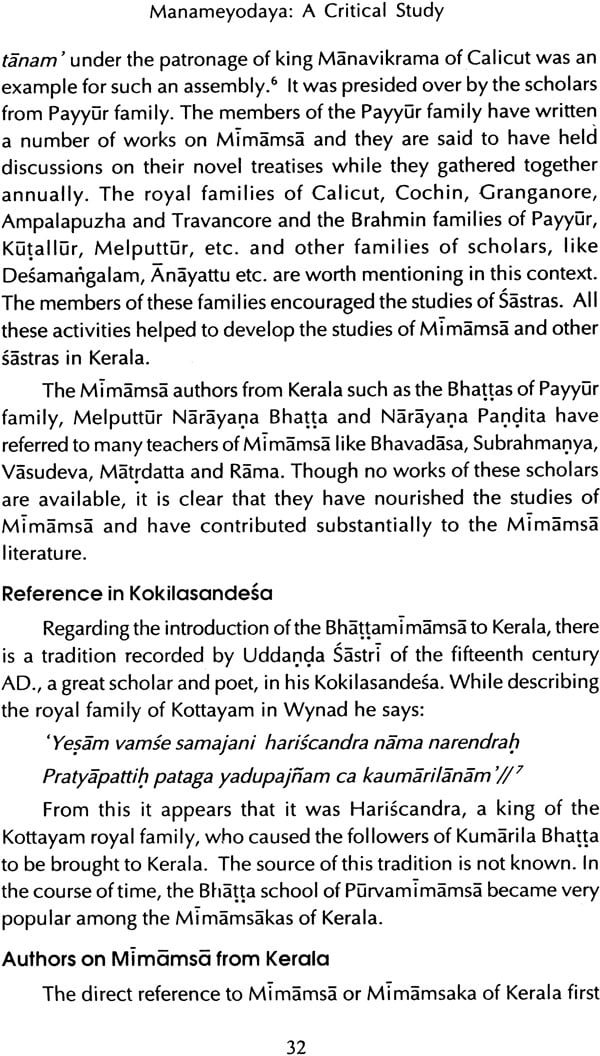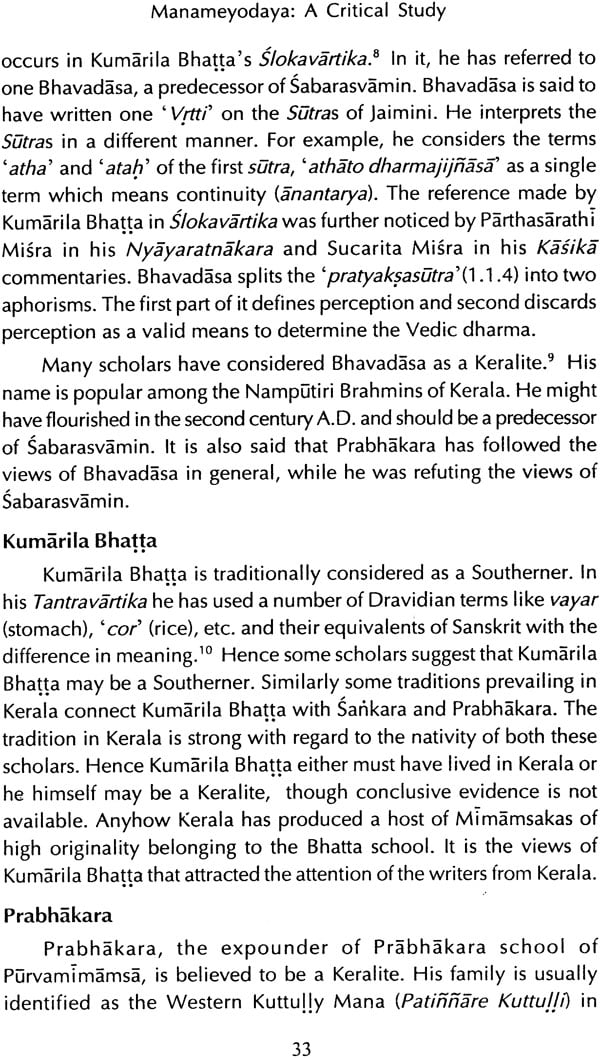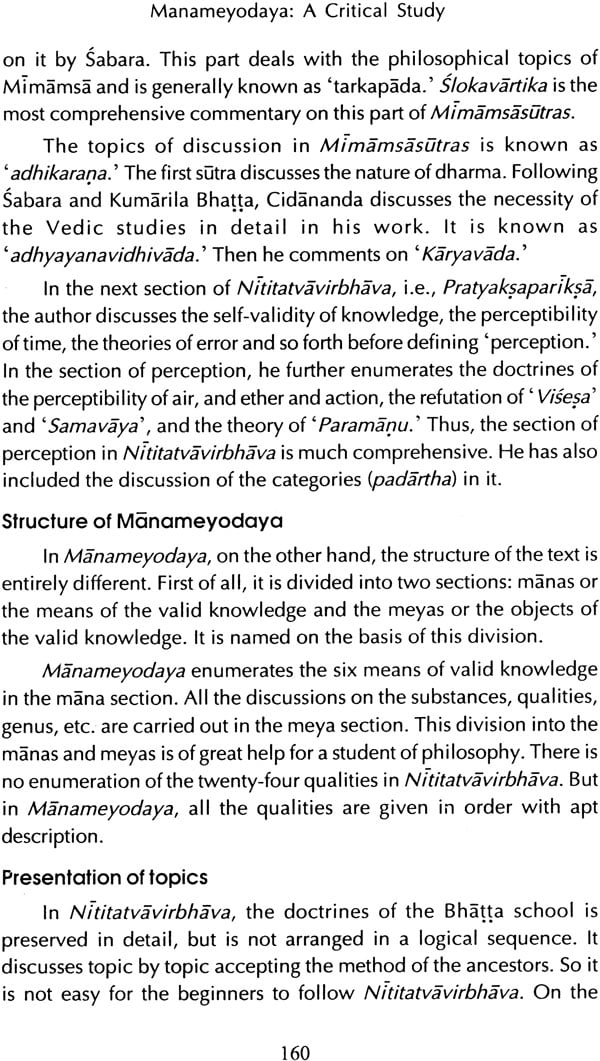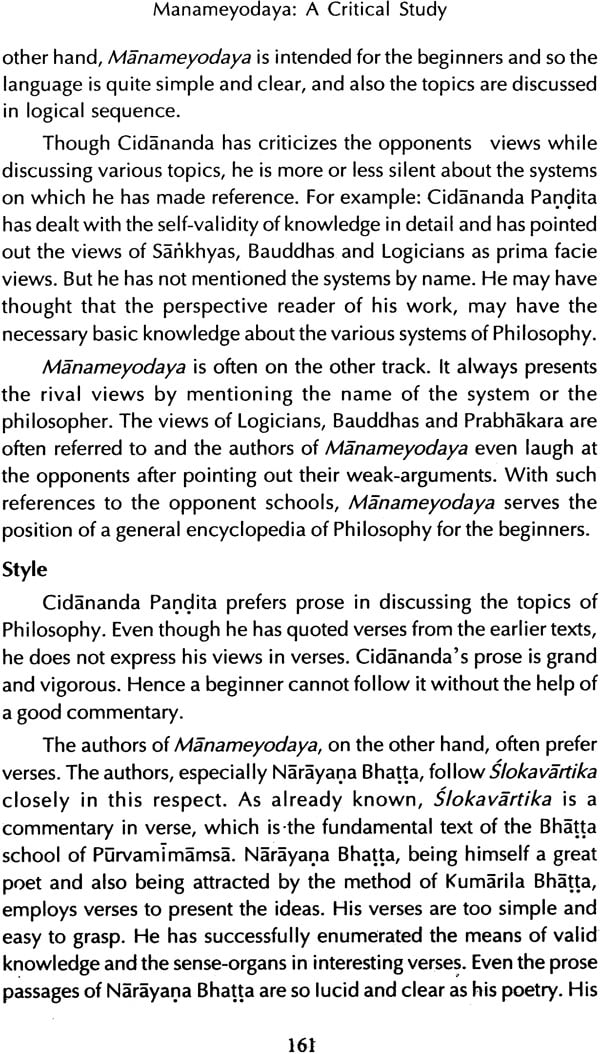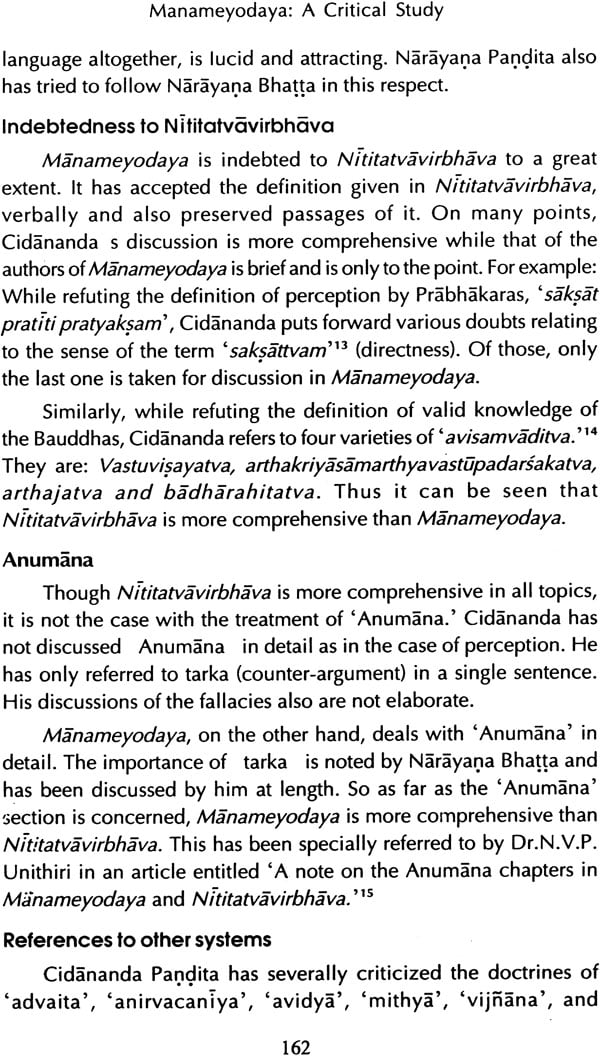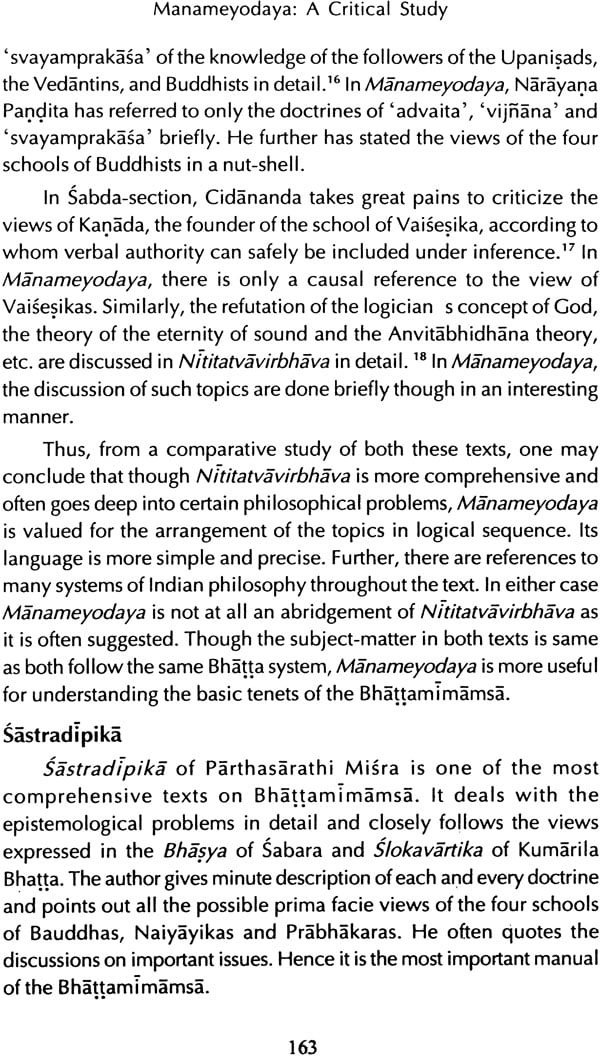
Manameyodaya: A Critical Study
Book Specification
| Item Code: | NAH451 |
| Author: | Dr. V.R. Muralidharan |
| Publisher: | Publication Division University of |
| Language: | English |
| Edition: | 2011 |
| ISBN: | 9788177481686 |
| Pages: | 184 |
| Cover: | Paperback |
| Other Details | 8.0 inch x 5.5 inch |
| Weight | 200 gm |
Book Description
Mimamsa as a separate school of Indian philosophy deals with the ritualistic part of the Vedic literature, the earliest extant work of the school being the Sutras of Jaimini (200 BC). Though earlier writers like Sabara refer to the subject matter of the system by words like Vicara, Nyaya etc. meaning investigating into the real import of the Vedic sentences, by the time of Kumarila Bhatta (600-720 AD) the word Mimamsa became an established name of the school. Manameyodaya is a work of combined authorship the first part Mana, being composed by Narayana Bhatta. The author left in unfinished though he intended to write the second part as is evidenced by his statement atasta dubhayam brumah in the introductory verse of the work. The Meya part was composed by Narayana Pandita. Though it is considered to be an abridgement of Nititattvavirbhava of Cidananda, the work envisages Narayana Bhatta's profound scholarship in all systems of Indian philosophy and while presenting Bhatta views he also refutes the views of opponents like Prabhakara, Nyaya, Bauddha, and Samkara.
I have great happiness to publish Dr.V.R. Muralidharan's work Manameyodaya: A Critical Study as the 40th book under the Calicut University Sanskrit series.
Originally this is the result of Dr.V.R. Muralidharan's research work leading to Ph.D under the able supervision of Dr.K.N.N.Elayath.
I wish that scholarly world will receive this work with the same enthusiasm as in the case of the previous books in this series.
The present work, Manameyodaya: A Critical Study, is the doctoral thesis done by me in the department of Sanskrit, University of Calicut from 1987 to 1992 under the supervision of Dr. K.N.N. Elayath, Professor of Sanskrit department. Dr. Elayath has guided me not only to achieve the degree but kindled some basic interest in me to study the Purvamimamsa system of Indian Philosophy to some extent. Kerala's rich tradition in mimamsa and the contribution of Keralites like the members of Payyur family and Melputtur Narayana Bhatta deserve special mention. The text, Manameyodaya, is a notable manual on Bhattamimamsa authored by Melputtur Narayana Bhatta and Narayana Pandita.
I am thankful to all who have in one or other way prompted and helped in the publication of this work after a long span of two decades. Special mention may be needed about my supervising teacher, Dr. K.N.N. Elayath, and other teachers of the Department of Sanskrit like Dr. N.V.P. Unithiri, Dr.C.Rajendran, Dr.T.K.Narayanan, Dr. P. Narayanan Namboothiri and Dr. K. Sekharan. I am also thankful to Dr. K.K. Geethakumari, Head of the Department of Sanskrit who forwarded this book. My sincere thanks are due to Dr. N.K. Sundareswaran who again and again compelled me to complete the task. Finally I took this occasion to express my deep sense of gratitude to the University authorities for accepting this work for publication and doing the printing work laudably.
Manameyodaya authored by both Melputtur Narayana Bhatta (C.1560-1650AD) and Narayana Pandita (C.1585-1660AD) is one of the most remarkable philosophical manual of the Bhatta school of Purvamimamsa. Unlike the other works like Arthasangraha and Mimamsanyayaprakasa, it exclusively deals with the philosophical doctrines of Mimamsa and avoids the usual doubts and discussions regarding the rituals. Within the limits of an elementary treatise, it also presents the prima facie views of the rival systems like Nyaya, Prabhakaramimamsa and Buddhism and thus serves as a polemical but basic text of Bhatta school of Purvamimamsa.
Owing to the exhaustive treatment of Pramanas, Manameyodaya has attracted the attention of several scholars both eastern and western like A.B.Keith, Dr.S.Radhakrishnan, A.Subrahmania Sastri, Dr.K.Kunjunni Raja and others. A.B.Keith in his Karmamimamsa adopts the views of Sastradipika of Parthasarathi Misra and Manameyodaya to illustrate the philosophical doctrines of Kumarila Bhatta's school of Purvamimamsa. Dr.K.Kunjunni Raja, in his Indian Theories of Meaning, has frequently quoted to Manameyodaya while discussing some linguistic problems faced by the Bhattas. Thus even in the modern studies scholars have now begun to attach great importance to the study of Manameyodaya while dealing with the topics of Mimamsa philosophy.
One of the main reasons for the interest shown by modern scholars in Manameyodaya is its logical method of presenting the philosophical doctrines of the Mimamsa system. The style of presentation and arrangement of topics are done methodologically unlike the prosaic style usually seen in the sastraic texts. The authors of Manameyodaya were great poets and critics of Sanskrit literature as a whole. Hence they could excel all other earlier writers in presenting systematically and poetically the doctrines of the Mimamsa philosophy and attract the attention of the modern scholars.
Manameyodaya, thus, is an important primer and is widely read as a basic text on Mimamsa throughout India even today. Hence an attempt to discuss the fundamental philosophical tenets of the Purvamimamsa school in Indian Philosophy with special reference to Manameyodaya is most appropriate and relevant.
The introductory section presents a brief survey of Mimamsa in general and the contribution Kerala has made to Mimamsa literature in particular. This is followed by a detailed account of the dual authors of Manameyodaya. The next section, aims at presenting the means and objects of valid knowledge accepted by the Bhattas. In this context mainly basing on Nyayasiddhantamuktavali and Prakaranapancika, prima facie views of Naiyayikas and Prabhakaras are explained in great detail. Among the works on Bhattamimamsa, Slokavartika Sastradipika and Nititatvavirbhava are occasionally referred to. In the next section, the influence of early writers on Manameyodaya is briefly narrated and the importance of Nititatvavirbhava is highlighted. Some critical remarks on the work Manameyodaya and its style, etc, are included in the last chapter of the study.
| Foreword | 7 |
| Introductory | 9 |
| Preface | 11 |
| Introduction | 13 |
| 1. Mimamsa in Kerala | 30 |
| 2. Manameyodaya and its authors | 44 |
| 3. Prama and Pramana | 67 |
| 4. Pratyaksa | 83 |
| 5. Anumana | 93 |
| 6.Sabda | 104 |
| 7. Upamana, Arthapatti and Abhava | 115 |
| 8. Prameyas -The Categories of Mimamsa | 127 |
| 9. The Concept of Self | 145 |
| 10. Influence of early writers on Manameyodaya | 157 |
| 11 . Conclusion | 166 |
| Bibliography | 178 |
